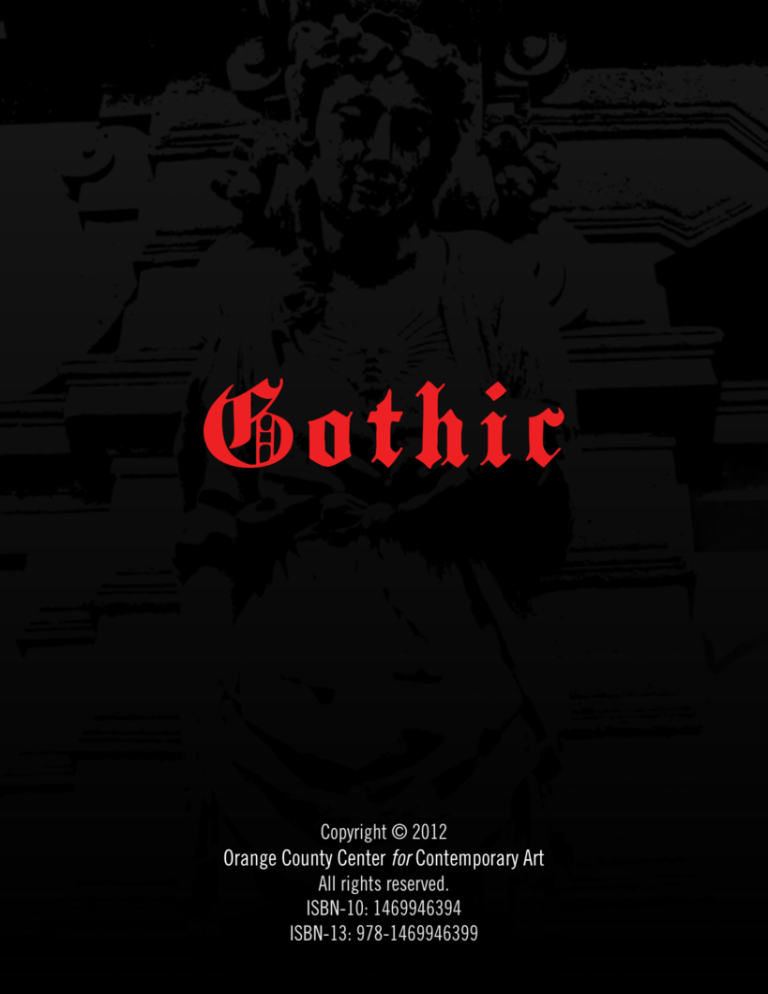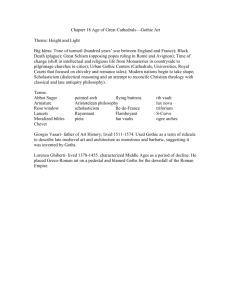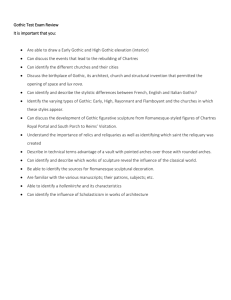
G o thi c
Copyright © 2012
Orange County Center for Contemporary Art
All rights reserved.
ISBN-10: 1469946394
ISBN-13: 978-1469946399
Juror: Amy V Grimm: .
Gothic invites submission from artists evincing a
peculiar, perverse, idiosyncratic sensitivity, influenced by
literature, movies, television and the tabloids, in painting, drawing, sculpture, illustration, fashion, graphic
design, animation, photography, video, digital media,
computer-based works, installation and performance.
OCCCA’s museum of the macabre will display supernatural mutations, bizarre curiosities permeated by fantastic and pathological themes.
Gothic is a mix of Medievalism, Romanticism,
science fiction, Victoriana, punk, the uncanny, the
grotesque, and the erotic, inseparable from despair, fear
and rapture. Gothic reveals the shadow within, the skull
beneath the skin.
Text by Rob Mintz
Bibliography
Gilda Williams, ed., Documents of Contemporary
Art, The Gothic, MIT/Whitechapel, 2007.
Christoph Grunenberg, ed., Gothic: Transmutations of Horror in Late-Twentieth Century Art,
Boston: The Institute of Contemporary Art/Cambridge, Massachusetts: The MIT Press, 1997.
The Blur of the Otherworldly: Contemporary Art,
Technology, and the Paranormal. Baltimore:
Center for Art and Visual Culture, University of
Maryland, 2006.
1
2
Amy V. Grimm is an Independent Curator
and Assistant Professor of Art History &
Museum Studies at Irvine Valley College.
Grimm received her B.A. in Psychology from
the State University of New York in New Paltz,
New York. She received a Graduate Certificate
in Museum Management and a M.A. in Art
History from the University of South Carolina,
Columbia, South Carolina. Grimm’s M.A.
Thesis, is titled, “Andy Warhol: An Inquiry into
Self Identity and Portraiture”. Ms. Grimm’s
area of specialization includes Modern and
Contemporary European and American Art.
Grimm’s museum and academic career spans
over fifteen years including work for the Albany
Institute of History & Art, the South Carolina
State Museum, the El Paso Museum of Art, and
the Long Beach Museum of Art.
Grimm is past president of the Border Museum
Association in El Paso, Texas; an organization
that sponsors events to promote international
arts partnerships. Working for the College Art
Association, Grimm has developed annual
conference programming in cities such as
Seattle, Atlanta, Boston and New York. For the
College Art Association’s Annual Conference
in 2007, in New York City, Grimm chaired the
panel Out of the Frame: Creativity and Change.
This panel addressed curatorial risk taking in
light of controversial topics and technological
challenges. Also during the 2007 conference,
Grimm curated The Media Lounge, a unique
space dedicated to showing contemporary
new media, such as the MIT Media Lab,
Potter-Belmar Labs and several independent
filmmakers and videographers.
As a museum curator, Grimm has developed
and supervised over 40 exhibitions including
independent projects and museum
collaborations. Notable exhibitions include, Out
of Eden: The Sculptural Work of Harry Geffert
for the El Paso Museum of Art, and Sweet
Subversives: Contemporary California Drawings
for the Long Beach Museum of Art. Grimm’s
scholarship related to exhibition programming
and independent critical reviews have been
published as museum catalogs and articles in
national publications such as Sculpture and
Artlies magazines.
Grimm continues to lecture extensively on
topics such as Andy Warhol, Contemporary Art
and Museum Studies. As an Assistant Professor
of Art History & Museum Studies, Grimm is
developing a new undergraduate program
in Applied Museum Studies for Irvine Valley
College. Students participating in the program
will gain the knowledge and skills necessary
for a variety of employment opportunities, in
museums and other arts organizations.
Juror’s Statement:
The Gothic genre is heavily influenced by late 18th century literature. During this time
writers looked back to medievalism (such as Dante Alighieri’s 14th-century epic poem
Divine Comedy) and included fantastic tales that included atmospheric worlds, secret
passageways, and screams in the dark. This type of literature was extremely popular
at the time and writers within this genre included Anne Radcliffe, Bram Stroker, Mary
Shelley and later Edgar Allen Poe. The visual art world was closely aligned to these
writers with their shared interest in the supernatural and the horrifying. Visionary and
idiosyncratic artists such as Gustave Doré, William Blake, Francisco de Goya, and
Henry Fuseli come to mind with their psychologically expressive and erotic works of art.
Today the term Goth is also linked to a much larger sub-culture, of black clothed Goth
enthusiasts (Gothicists) who enjoy the cross-pollination in the arts and who are major
consumers of Goth culture. Musical groups such as The Cure, Crüxshadows, Siouxsie
and the Banshees and many others fall into this dark and moody genre. Gothic visual
expression is heavily influenced by comic books and graphic novels. In the comic book,
The Crow, by James O’Barr we see O’Barr unleash his psychological pain with epic violence on each page that inspired a film adaptation of the same name. The film version
of the Crow comic was a precursor to the successful film adaptation of Frank Miller’s
comic Sin City.
The merging of literature, film, music and the visual arts is the core strength of the
Gothic subject. Each artist included in this exhibition approached the subject utilizing
a wide range of materials often in very unique ways to address the exhibition’s concept. Despite the eclectic nature of the exhibition, many consistent themes are addressed such as death, transformation, outsider status and physical and psychological
trauma. The works reflect each artist’s particular relationship to Goth. These visual
expressions are the critical links to the past, present and future of this complex interdisciplinary genre. And, society’s insatiable appetite for all things Gothic is testament
to the need to understand and express the darkness that makes us human.
Amy V. Grimm, Art Historian & Independent Curator
3
4
Foreword:
Classic Gothic artists -- Gustave Doré, William Blake, Francisco de Goya, and Henry Fuseli -- created psychological
expressions. Today this is still relevant and Goth is still very
much alive. Grimm looked at approximately 900 works, narrowing the list down to around 60. The submissions were heavily
figurative with a large amount of digitally manipulated photography. Those artists that stood out often addressed issues
of the body/mind and pleasure and pain, with a spirited mix
of performance, digital films, two and three dimensional work
with an edge that makes for a spine tingling show.
Amy Grimm, juror for the Gothic exhibition at OCCCA, sees
human fascination with Gothic as an interest in “pleasurable
fear.” Since time immemorial, people thrill to scary stories,
the macabre, being in the twilight zone, a bit scared, and a bit
energized. Consider Mary Shelley’s Frankenstein, published in
1818, a Gothic novel, one of the earliest examples of science
fiction, and a piercing exploration into life and death.
While this Gothic exhibition is mainly about artistic expressions, one can also see how today’s filmmakers, musicians,
and fashion designers have used Gothic as a way of projecting
an often terrifying identity in clothing, hairstyles and sound.
Gothic mass appeal took place in the 1970s when Gothic became Goth in the music scene in London. A Goth identity also
managed to reach far-flung college towns where teens and
older used the term Goth that veered off to become Goth-Punk,
a way of middle-class kids to become different, anti-establishment, often wearing black, Mohawk hairstyles, tattoos, even
when they were mainstream in every other way.
Lisa Folino’s photograph shows a window and slats that decayed in a haunting black and white abstract pattern; while
Carrie Ann Baade paints a queen-like woman in black mysteriously holding and surrounded by rabbits. Lance Larson creates
a close-up of a most tormented face; Kelley Hensing portrays
a man with an enormous headdress of swarming flying insects
to depict him ruminating. And Sayuka Bloodstone designed a
graceful book label of a swirling and appealing Gothic woman.
In this exhibition, artists look at a range of excessive emotions
and their expressions that realistically are beyond the desired
happy, pretty, and healthy. Gothic art fills this gap and will
challenge viewers who may find meaning, even beauty in the
grotesque.
People are attracted to the scary as a way of dealing with
anxieties that are both desirable and frightening. The Gothic
may keep people at a distance, yet there is much that is mesmerizing, to come closer and engage in its heightened drama.
Gothic is a form of protection and armor to the extreme. Add
to this that the Gothic artistic movement was accelerated by
global communication that mixes pop, graffiti, cartoons, eroticism and surrealism; and often spoofs the conventional and
“normal.” Consider too that life can be extremely difficult, not
always pleasurable.
5
Roberta Carasso, Ph.D., art writer and art consultant.
6
Janice Arnold
Adrian Avila
Centralia, Washington, United States. www.jafelt.com
My installations are a marriage of art, architecture, and history. I strive to create atmospheric and otherworldly environments through the traditional process of Felting - the making of strong non-woven material
from nothing more than raw wool fibre. This alchemy of wool, water, aesthetic and toil is in itself a driving
force behind my work.
7
Chthonic Tent
8 x 20 x 8 feet
Handmade felt- wool, metal, lyocell, silk, mohair
Bullhead City, Arizona, United States. enolapro.blogspot.com
Adrian Avila, feels that art is a way of expressing what you really see. Everyone sees things differently, but
only those who seek to know and understand each other’s differences make the difference in showing one’s
art. To see the naked truth in everything, including himself, could be either shockingly disturbing or heavenly beautiful.
8
HELLO
28 x 43 inches Watercolor on matboard
Valerie Labelle-Desmarais
Lance Larson
Princeton, New Jersey, USA. www.labelledesmarais.blogspot.com
I am interested in relationships we have consciously and unconsciously with the natural world through
myths, ancient and modern. My focus is on endangered species and endangered climates of the North.
Their fate is ultimately our own.
43
untitled
28 x 36 inches
Caribou antler, taxidermized robin, fabric, wax, copper leaf, cardboard
Non-manipulated photography
44
Untitled
12 x 9 inches
Print on wood
El Segundo, California, United States. lancelarsondesign.com
Christopher Leonhardt
Patrick Loehr
Long Beach, California, United States.
Arvada, Colorado, United States. www.patrickloehr.com
Through various media including photography, drawing and digital technology, I borrow Gothic themes
(such as transformation, perversion, and family secrets) and utilize these subjects to explore concepts of
‘objectivity’ and ‘normality’.
45
The Tower - From The Esoteric Male Series
16 x 20 inches
Digital photograph
46
Portrait of a Lady (with Raven)
20 x 30 inches
Ink print on stretched canvas (digital media composition)
Fin
Loic Zimmermann
65
Farewell
16 x 20 inches
Giclee, signed, framed, with plexi
Santa Monica, California, United States. www.e338.com
66
Published On the Occasion of the Exhibition:
Gothic
An International Call for Art
February 2nd - March 24th, 2012
Orange County Center for Contemporary Art
Santa Ana, California. United States
Juried By Amy V. Grimm
OCCCA Administration, 2012:
Executive Director: Stephen Anderson
Assistant Director: Jeff Alu
Exhibitions Director: Lisa Popp
Treasurer: Christina Ponce
Secretary: Kebe Fox
Advisory board:
Chair: Stephen Anderson,
Assistant Chair: Lisa Popp
Pam Grau
Sali Heraldez
David Michael Lee
Joella March
Jon Webb
Kevin Wilkeson
117 N. Sycamore, Santa Ana, CA 92701
7 1 4 . 6 6 7 . 1 5 1 7 • www. o c c c a . o r g
Design: Stephen Anderson; www.MixedMediaExpressions.com
Cover Photo: Stephen Anderson
Foreword by: Roberta Carasso, Ph.D., art writer and art consultant
Edited by: Melanie Kehoss & Burton Rein
67
© 2012 Orange County Center for Contemporary Art
68









